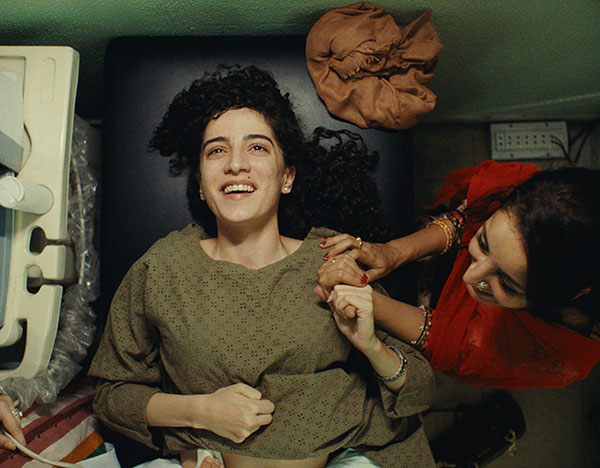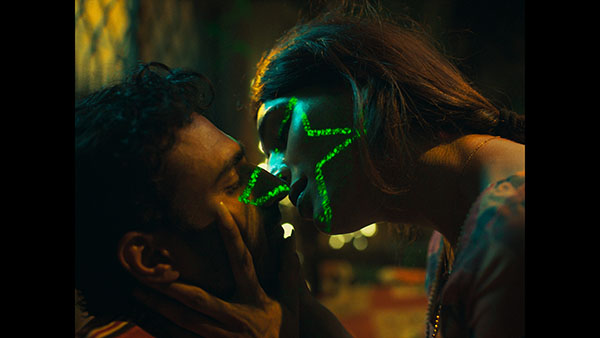We sat down with director/writer Saim Sadiq for an interview about Joyland, his feature film debut which unwaveringly highlights the dangers of the patriarchy.
In 2019, director/writer Saim Sadiq made history with his short film Darling, which became the first Pakistani film to premiere at Venice Film Festival. Three years later, with Joyland, he is again breaking barriers. His feature length debut focusses on the destructive nature of the patriarchal society in Pakistan, although its themes are universal. Joyland is a wide-reaching commentary on the human lives that are diminished and dehumanised by embedded bigotry inflicted upon them.
Set in a district of Lahore, Saim Sadiq’s film follows three main characters: Haider (Ali Junejo), Mumtaz (Rasti Farooq), and Biba (Alina Khan). How their different genders are treated by those around them – family, friends, strangers, of both younger and older generations – forms the crux of Joyland. As a man, Haider is expected to lead and provide for his family, and his soft, mild-mannered personality is treated discerningly by his brother and father. His wife, Mumtaz, wants to work and enjoy simple societal freedoms, but patriarchal expectations surrounding motherhood and what it means to be a wife drastically diminish these dreams. As a transwoman, Biba is viewed as a female by very few people, which strips away the very basis of her identity.
After joining an erotic dance theatre as a performer, Haider meets Biba, and the trio’s lives become complicated further as repressed feelings and desires simmer to the surface. As these characters and stories converge, Joyland gives us moments of celebration and suffering, liberation and restraint, all driven forward by evocative visuals of great symbolism and powerful performances from all three actors.
Before Joyland ’srelease in the UK, we sat down with Saim Sadiq for an interview, discussing the film’s raw power, Sadiq’s influences in writing a story of this magnitude, and how he managed to capture and connect themes of transphobia, misogyny, homophobia, and masculinity so impressively. Read our interview with Saim Sadiq below.
REPRESENTATION & INSPIRATION: SAIM SADIQ ON JOYLAND ’S IMPORTANCE
Thank you for speaking to us today. Joyland is fantastic. It is so visually captivating, and I was so deeply moved by it. It is the first Pakistani feature film to premiere at Cannes and to be shortlisted at the Oscars, as well as being the first to feature a trans actor in a lead role. Did you feel this huge importance when making Joyland and could you speak about the representation within the film?
Saim Sadiq: It certainly felt important in terms of how important the story is to me. I always approached the film in that bracket. It is my first film, and I can’t control if any other person watches it or likes it. I can only be certain of one viewer’s reaction: my own. I wanted to make a film that I would watch and like as a viewer, so I just needed to be true and honest to how I would want to shoot a scene, represent these characters, and structure the film.
The motivations were very selfish. I never thought of it as ‘this film is important’ or ‘these themes are important’. Of course, I know they are, because of how accelerated the discourse on themes such as sexuality and gender has become in the last decade, but that was never the motivation to make the film.

What was the inspiration behind Joyland? What brought you to this story?
SS: I’ve lived in Pakistan since I was born, here in Lahore where Joyland is set. There is a specific family structure here. As a child, I used to have conundrums and conflicts with regards to being a certain way as a man, like playing a certain sport to prove your masculinity, or walking a certain way. You have to do so much to prove you’re a man, but I was born a man and that should be enough, no matter how I choose to live my life.
You have to deal with the constant idea of tradition versus freedom, where you almost have to create two lives for yourself. One is social and visible, and the other is invisible and just for yourself. This is true for people everywhere in the world. The ideas in the film around sexuality, gender and invisibility came from all of these experiences. They also produced the idea of a triangle, made up of a man, woman and trans woman dealing with these things. Everything I wanted to talk about came into the film’s story.
THEMES: SAIM SADIQ ON JOYLAND ’S COMMENTARIES
In terms of those themes, you have transphobia, transgenderism, homophobia, misogyny, masculinity, and how patriarchy influences all of them. How did you find balance and connection between these themes? There is a lot going on, but you portray everything so effectively with great depth.
Saim Sadiq: It was difficult to be honest to all of these characters’ individual experiences, because of the ensemble nature of the film. I wanted to curate enough time for each character. Structurally, it was tricky. But I never really approached it like that, in terms of thinking, ‘this is a film that needs to address this set number of issues’.
It really all boils down to patriarchy. Transphobia, homophobia, it all exists because of patriarchy. For me, it was just about portraying a true picture of a patriarchal society and family, with all of the other elements coming into fruition through this, with each character in the ensemble facing it in a different way. It was about all of them finding no joy in this kind of system.
There is a lot of sadness and suffering in Joyland, but also playful moments of happiness. Haider in particular is quite an amusing character. Was this intentional? Was it important to have these lighter moments amidst the tougher parts?
SS: It was very intentional. Just because there is suffering, it doesn’t mean these characters are living in a constant state of misery. There are a lot of joy, love and comfort to be found. There is also a lot of humour to this schizophrenic way of existing, like these erotic dance theatres being right next to your house, but no one talking about them. The humour is inevitable when Haider walks into this theatre and we already know what his family is like. I wanted to play on that, so it would be more truthful to the existence of these characters that do have these moments of levity.
I loved the big cardboard cut-out of Biba – very iconic!
GETTING TECHNICAL: THE CAMERAWORK AND VISUAL STYLE OF JOYLAND
The camera frequently zooms in or out slowly during scenes. What did you hope to achieve with this style?
Saim Sadiq: I love zooms. I don’t know why people don’t use them more often! They are the stealthiest trick in the book.
We mainly used zooms in the house because I wanted a certain level of objectivity whenever two central characters come together. What they often want is conflicting, so I didn’t want to pick a side. I just wanted to be observational about it, without being too intrusive. The zooms allow the viewer to choose what to focus on. I wanted to give actors the space to be in a moment for themselves.

There are a lot of interesting framing choices in Joyland. Characters are often shot via their reflections in mirrors. In one scene between Haider and Mumtaz, they aren’t central in the shot, and instead they are pushed to the side and cut off slightly. Could you talk about what you were trying to achieve through these moments?
SS: There is actually an earlier shot in the film between Haider and Mumtaz, when we are zooming in whilst they go on with their normal lives. There is a playfulness and comfort between them, and no secrets at that point. You see them so fully and clearly. With the scene later in the film where they’re off-centre and slightly off-screen, I wanted to contrast it with that earlier moment. At this point, there is a secret between them; they both know it but won’t talk about it. I wanted to create a distance between them, even though physically they’re close on the bed. You yearn to see them together, but this scene creates a discomfort and anxiety.
In terms of shooting characters via mirrors, there are two reasons for it. One is logistical! I wanted to film scenes in single takes to retain the truthfulness. The mirror helps with blocking scenes. Secondly, thematically speaking, all of these characters are living dual lives. In all of these scenes, they are all trying to dabble between two worlds, so shooting them this way really enhanced the validity of this dual existence.
This interview has been edited for length and clarity.
Joyland is now available to watch on digital and on demand.

